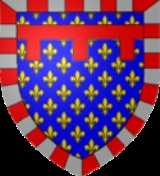
Charles, Duke of Durazzo
Encyclopedia

John, Duke of Durazzo
John of Gravina , Count of Gravina 1315–1336, Duke of Durazzo 1332–1336 and ruler of the Kingdom of Albania , was a younger son of Charles II of Naples and Maria of Hungary....
and Agnes de Périgord.
He succeeded his father as Duke of Durazzo and Count of Gravina in 1336.
On 21 April 1343, he married Maria of Calabria
Maria of Calabria
Maria of Calabria was the first Empress consort of Philip II of Taranto, titular Latin Emperor of Constantinople.-Family:...
, Countess of Alba, in Naples. She was the younger daughter of Charles, Duke of Calabria
Charles, Duke of Calabria
Charles, Duke of Calabria was the son of King Robert of Naples and Yolanda of Aragon.-Biography:Born in Naples, he became Duke of Calabria in 1309 on his father's accession, and was created Vicar-General of the Kingdom of Sicily...
and sister of Joan I of Naples
Joan I of Naples
Joan I , born Joanna of Anjou, was Queen of Naples from 1343 until her death. She was also Countess of Provence and Forcalquier, Queen consort of Majorca and titular Queen of Jerusalem and Sicily 1343–82, and Princess of Achaea 1373/5–81....
, and had been intended as a bride for Louis I of Hungary or John II of France
John II of France
John II , called John the Good , was the King of France from 1350 until his death. He was the second sovereign of the House of Valois and is perhaps best remembered as the king who was vanquished at the Battle of Poitiers and taken as a captive to England.The son of Philip VI and Joan the Lame,...
, but was abducted by Charles and his mother to make a marriage that would place Charles closer to the throne of Naples.
Keeping carefully aloof from the conspiracy that murdered Joan's husband Andrew, Duke of Calabria
Andrew, Duke of Calabria
Andrew, Duke of Calabria was the second surviving son of Charles I of Hungary and Elizabeth of Poland...
, he led a faction opposing Joan and Louis of Taranto
Louis of Taranto
Louis I of Naples , of the House of Anjou, was the Prince of Taranto from 1346 and King of Naples from 1352. He was a son of Philip I of Taranto and Catherine II of Valois, Princess of Achaea. His paternal grandparents were Charles II of Naples and Maria of Hungary...
. He hoped to turn the invasion of Louis of Hungary and the flight of Joan to his own ends: but he was seized and beheaded by the Hungarians at Aversa
Aversa
Aversa is a town and comune in the Province of Caserta in Campania southern Italy, about 15 kilometres north of Naples. It is the centre of an agricultural district, the agro aversano, producing wine and cheese...
.
Alexandre Dumas, père
Alexandre Dumas, père
Alexandre Dumas, , born Dumas Davy de la Pailleterie was a French writer, best known for his historical novels of high adventure which have made him one of the most widely read French authors in the world...
, in his romance Joan of Naples, makes Charles a master of intrigue and treachery who engineers the death of Andrew and then of his murderers, only to meet his death at the hands of the King of Hungary.
Issue
Charles and Maria had five children:- Louis (December 1343 – 14 January 1344)
- JoannaJoanna, Duchess of DurazzoJoanna of Durazzo was the eldest daughter and eldest surviving child of Charles, Duke of Durazzo and his wife Maria of Calabria. She succeeded as Duchess on the death of her father in 1348 when she was only a child of four years old. Joanna was a member of the House of Anjou-Durazzo.She reigned as...
(1344 – 1387), Duchess of Durazzo; married first in 1366 Louis of Navarre, Count of Beaumont (d. 1372), married second Robert IV of Artois, Count of EuRobert IV of Artois, Count of EuRobert IV of Artois , son of John of Artois, Count of Eu and Isabeau of Melun, was Count of Eu in 1387.About 1376, he married Joanna of Durazzo, daughter of Charles, Duke of Durazzo. He was poisoned and died in the Castel dell'Ovo, Naples....
(d. 1387) - AgnesAgnes of DurazzoAgnes of Durazzo was the Empress consort of James of Baux, titular Latin Emperor of Constantinople. She was the last consort of the Latin Empire.-Family:She was the second daughter of Charles, Duke of Durazzo and Maria of Calabria...
(1345 – 1388, Naples), married first on 6 June 1363 Cansignorio della ScalaCansignorio della ScalaCansignorio della Scala was Lord of Verona from 1359 until 1375, initially together with his brother Paolo Alboino.-Biography:...
, Lord of Verona (d. 1375), married second James of BauxJames of BauxJames of Baux , Duke of Andria, was the last titular Latin Emperor of Constantinople from 1374 to 1383 and Prince of Achaea from 1382 to 1383....
(d. 1383) - Clementia (1346 – 1363, Naples)
- Margaret (28 July 1347 – 6 August 1412, MelaMelaMela is a Sanskrit word meaning 'gathering' or 'to meet' or a Fair. It is used in the Indian subcontinent for all sizes of gathering and can be religious, commercial, cultural or sports. In rural traditions melas or village fairs were of great importance...
), married in February 1368 Charles III of NaplesCharles III of NaplesCharles the Short or Charles of Durazzo was King of Naples and titular King of Jerusalem from 1382 to 1386 as Charles III, and King of Hungary from 1385 to 1386 as Charles II. In 1382 Charles created the order of Argonauts of Saint Nicholas...

